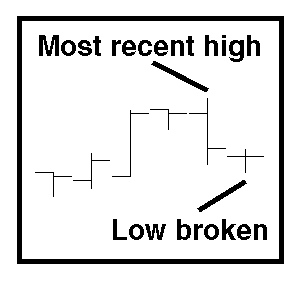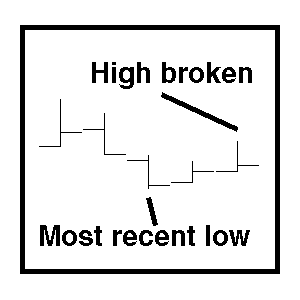Pivot point charts connect pivot highs with pivot lows. A pivot point high occurs when prices are advancing and the low of the most recent high bar is broken. At this point, the most recent high bar becomes the pivot high day.

In the above example, prices are advancing and the second bar from the right is the most recent high bar. When the low of this bar is broken by the last bar on the right, the second bar from the right becomes the pivot high bar.

In the above example, prices are advancing and the third bar from the right is the most recent high bar. When the low of this bar is broken by the last bar on the right, the second bar from the right becomes the pivot high bar. Note that in this example, the low of the high bar is not broken by the bar just to the right of it.
A pivot point low occurs when prices are declining and the high of the most recent lowest day is broken. At this point, the most recent low day becomes the pivot low day.

In the above example, prices are declining and the second bar from the right is the most recent low bar. When the high of this bar is broken by the last bar on the right, the second bar from the right becomes the pivot low bar.

In the above example, prices are declining and the third bar from the right is the most recent low bar. When the high of this bar is broken by the last bar on the right, the second bar from the right becomes the pivot low bar. Note that in this example, the high of the low bar is not broken by the bar just to the right of it.
Reference: Hill, John R. Stock & Commodity Market Trend Trading by Advanced Technical Analysis. Hendersonville, North Carolina: Commodity Research Institute, Ltd., 1977.